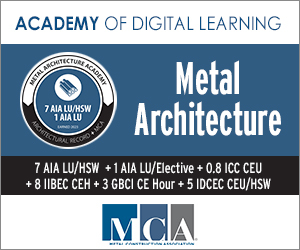Sustainable Construction
 1 AIA LU/HSW; 0.1 ICC CEU; 1 IIBEC CEH; 0.1 IACET CEU*; 1 AIBD P-CE; AAA 1 Structured Learning Hour; This course can be self-reported to the AANB, as per their CE Guidelines; AAPEI 1 Structured Learning Hour; This course can be self-reported to the AIBC, as per their CE Guidelines.; MAA 1 Structured Learning Hour; This course can be self-reported to the NLAA.; This course can be self-reported to the NSAA; NWTAA 1 Structured Learning Hour; OAA 1 Learning Hour; SAA 1 Hour of Core Learning
1 AIA LU/HSW; 0.1 ICC CEU; 1 IIBEC CEH; 0.1 IACET CEU*; 1 AIBD P-CE; AAA 1 Structured Learning Hour; This course can be self-reported to the AANB, as per their CE Guidelines; AAPEI 1 Structured Learning Hour; This course can be self-reported to the AIBC, as per their CE Guidelines.; MAA 1 Structured Learning Hour; This course can be self-reported to the NLAA.; This course can be self-reported to the NSAA; NWTAA 1 Structured Learning Hour; OAA 1 Learning Hour; SAA 1 Hour of Core Learning
Learning Objectives:
- Discuss how the durability of metal as a building material can contribute to the sustainability of buildings.
- Explain some key qualities of metal that make it an ideal material selection when incorporating renewable energy goals into building plans.
- List the financial and aesthetic benefits of choosing metal for walls and roofs.
- Describe the importance of considering a cradle-to-cradle approach when specifying building materials to address carbon emissions and climate change.
This course is part of the Metal Architecture Academy
Single-Skin Panels
As with MCM panels, single-skin metal panels, also known as preformed or roll-formed, are made from different metals, such as steel, aluminum, copper, and zinc, with metallic-coated steel being the most common in commercial building construction. Single-skin panels were initially used for large industrial projects such as warehouses and manufacturing plants. With more recent advances in metal panel manufacturing and finishing, and with more profile designs, single-skin panels can be used on almost any type of building.
Single-skin panels have also become remarkably versatile in commercial construction. For years, panels were limited to vertical installations. Now the panels are designed for many different installation options, including horizontal, diagonal, geometrically patterned, and curved. Perforated panels are also available. Single-skin panels can be used for bold statements on building exteriors while maintaining durability.
As with IMP and MCM, single-skin panels are treated with protective finishes. These preformed panels also are relatively economical to install, especially when compared to other building materials such as the synthetic stucco of exterior insulation finishing systems (EIFS). Preformed panels allow quick installation, thus saving time and money.
Benefits of Metal Roofs
Many of the same characteristics that make metal a smart choice for walls also make it ideal for roofing. Between the overall durability of the material and finishes, metal roofs can last for decades and contribute to the overall sustainability of a building. In addition to broad durability, metal roofs can be coated with finishes that reflect sunlight and reduce heat absorption, which in turn lowers cooling demands in summer. Many metal roof panels can provide excellent insulation, contributing to lower energy costs. Metal roofs make long-lasting, beautiful, and sustainable rooftop systems that contribute to the energy efficiency of the building. The metal used for roofs typically contains at least 25% recycled content, and when that roof reaches the end of its life, it will be 100% recyclable. The high recycled content can contribute to LEED credits for the project.
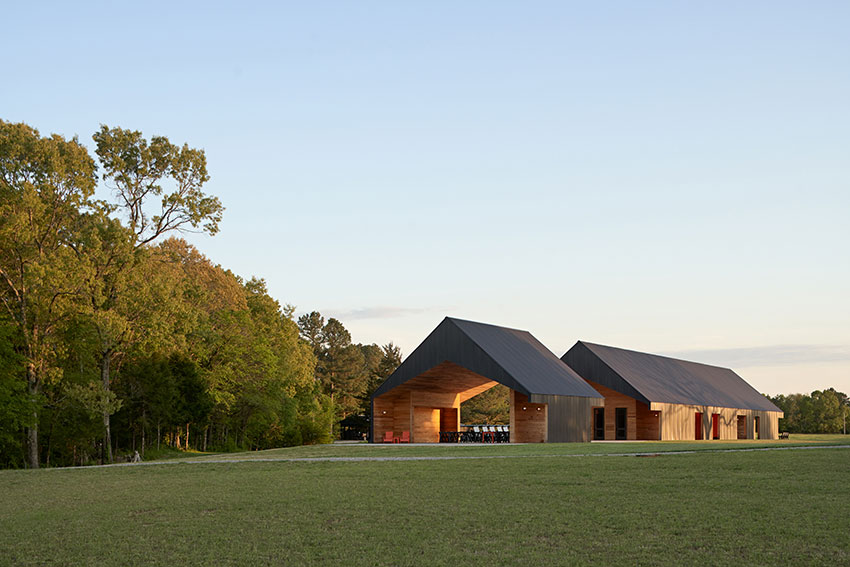
Photo: Mike Sinclair; courtesy of Sherwin Williams
Lone Oaks Farm Hunter Education Station, Middleton, Tennessee.
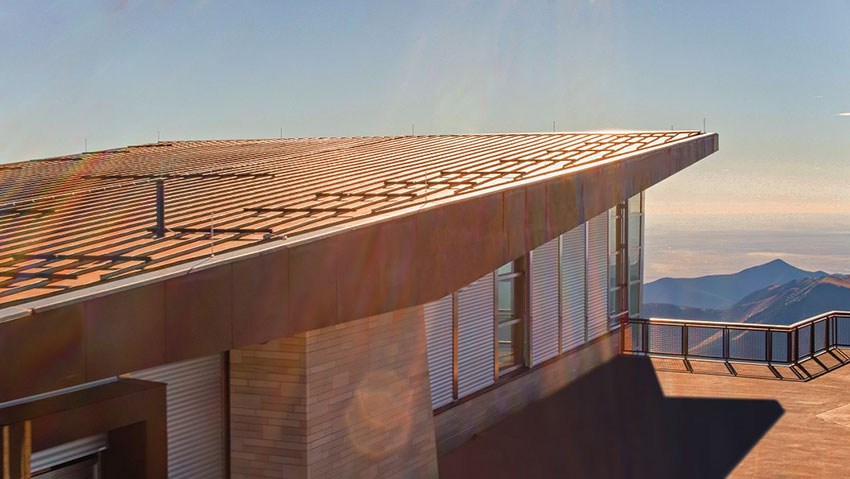
Photo courtesy of Drexel Metals
Pikes Peak Summit Complex, Colorado Springs, Colorado.
Low-Slope Metal Roofs
Low-slope metal roofs have a long history of being used to cover large building projects such as commercial or industrial structures. These roofing systems are exceptionally good at draining water away from the roof surface, thus extending the overall life of the roof and the building. As the name implies, low-slope metal panels are typically used on flatter rooftops that have pitches ranging from ¼:12 to 3:12. The roofing systems are made of interlocking panels with vertical and trapezoidal seams that run parallel to the roof slope, and are a good choice for larger-scale commercial projects in environments where the building will benefit from a long-lasting, lightweight roof. A lightweight roof is especially important in high seismic areas as it doesn’t add as much horizontal force as other heavier roofing materials.
Low-slope metal roofs can also include the traditional roofing method known as screw-down or through-fastened roofing. In these systems, the panels can easily be fastened directly over bar joists or purlins. This is a significant advantage over non-metal roofing systems, which can only be attached to an underlying substrate or roof deck. Not only does this save time and construction costs, but it also reduces the overall structural load. The fastening systems, which are interlocking or “active,” produce a highly resilient roof in high winds. From a standards perspective, uplift resistance of metal roof panel systems is determined by ASTM E1592, UL 580, UL 1897, and other uplift tests to ensure performance.
Moreover, large-scale projects that use low-slope roofs can benefit from the lengthy service life: these metal roofs can last 40 years or longer, depending on climate and manufacturer warranties.
Steep-Slope Metal Roofs
Steep-slope metal roofs have pitches of 3:12 or greater. They are available in many different metal types, with steel and aluminum as the most common, but copper and zinc panels are also options. Metal panels made from steel and aluminum are protected by high-performance, durable coatings that extend the longevity of the product. Copper and zinc naturally develop their own protective finish. All these roofing systems tend to be lightweight and wind resistant, and they are helpful for a building that requires a durable roof to shed water, snow, ice, and debris in order to avoid mold and mildew. The ability to release water and snow contributes to the overall durability, and manufacturers acknowledge that durability with warranties that range from 20 to 40 years, and in some cases more.
There are two categories of steep-slope metal roofs: structural and architectural. The main difference is how they are fastened to the underlying structure. Structural systems are available in several styles, such as vertical standing seam systems and corrugated or tile facsimile metal panel roofs. Vertical standing seam systems are attached to underlying purlins with hidden clips or fastening flanges. Corrugated systems, however, have fasteners attached through the metal panels, which either overlap or interlock on the side ends to ensure that the system is water-tight.
Structural systems can be attached directly to the building structure, but architectural steep slope metal roof systems can only be attached to an existing roof deck, such as plywood, oriented strand board, concrete, or metal. In addition to the vertical, corrugated, and tile options available with structural systems, architectural systems also include horizontal panel systems, shingles, and stamped metal tile.
Steep-slope metal roofs tend to be low maintenance in general. The reduced risk of water and debris build-up plays an important role in this, but so does the impact of protective coatings and finishes. These finishes are resistant to UV rays and protect the metal from acid rain, but they do more than just that. Through the application of heat-deflecting metal coatings, cooling loads may be reduced by as much as 40 percent or more, according to a study conducted by Oak Ridge National Laboratory. On top of functional benefits, steep slope metal roofs offer architects a wide range of colors and styles to enhance the design.
As with low-slope roofing systems, interlocking fastening systems are a key feature. Not only do they allow a relatively efficient installation, but the design also adds an additional level of protection against high winds.
Insulated Metal Roof Panel (IMP) Roof Systems
Insulated metal roof panels (IMPs) are at the top end of metal roofing products. They incorporate the best qualities of other metal roof options along with insulative properties born of a state-of-the-art design that bonds steel facings to the polyinsocyanurate insulating foam core. As a result, these roof systems provide exceptional and airtight thermal performance. IMPs can be used in almost any commercial or residential application regardless of the roof span, and they are equally applicable to low- and steep-slope roofs.
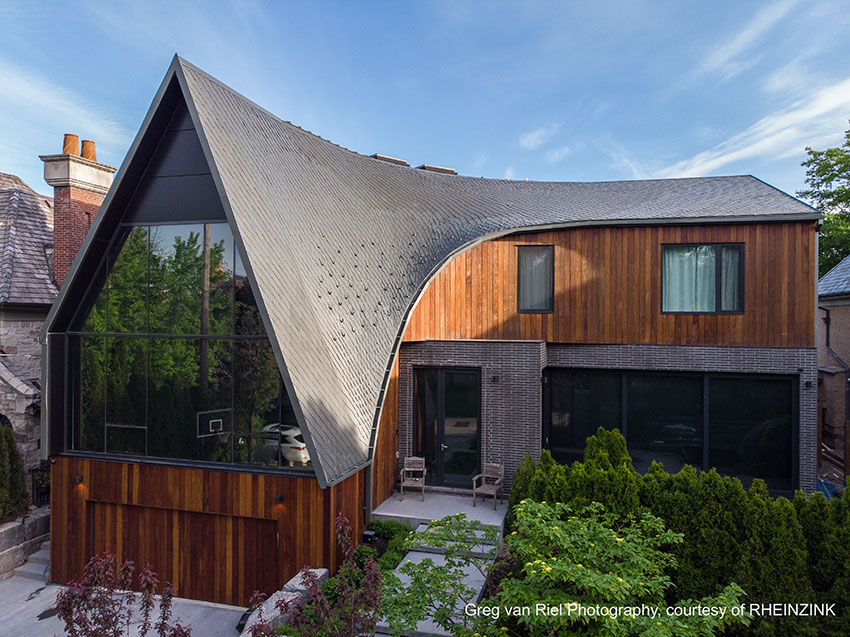
Photo courtesy of Rheinzink
Bézier Curve House, Toronto, Ontario.
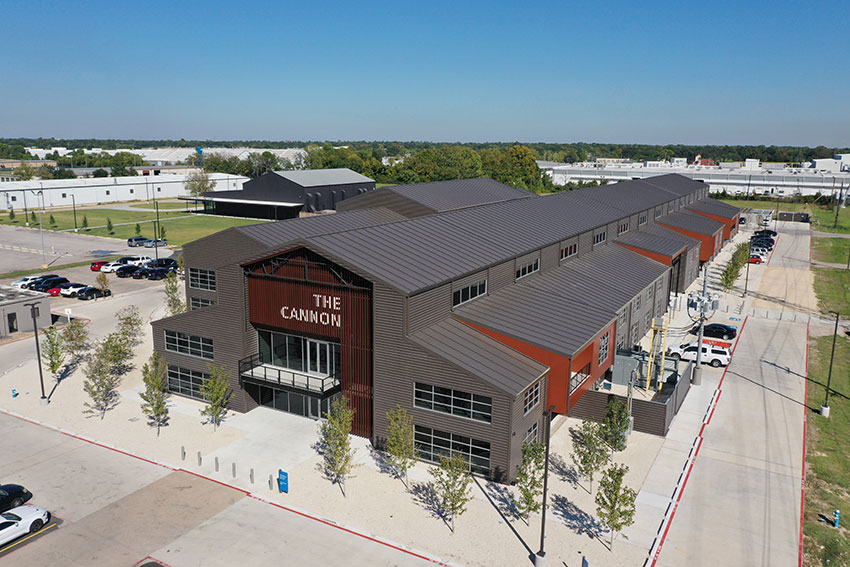
Photo courtesy of Nucor Corporation
Insulated Metal Panel Roof. The Cannon, Houston, Texas.







